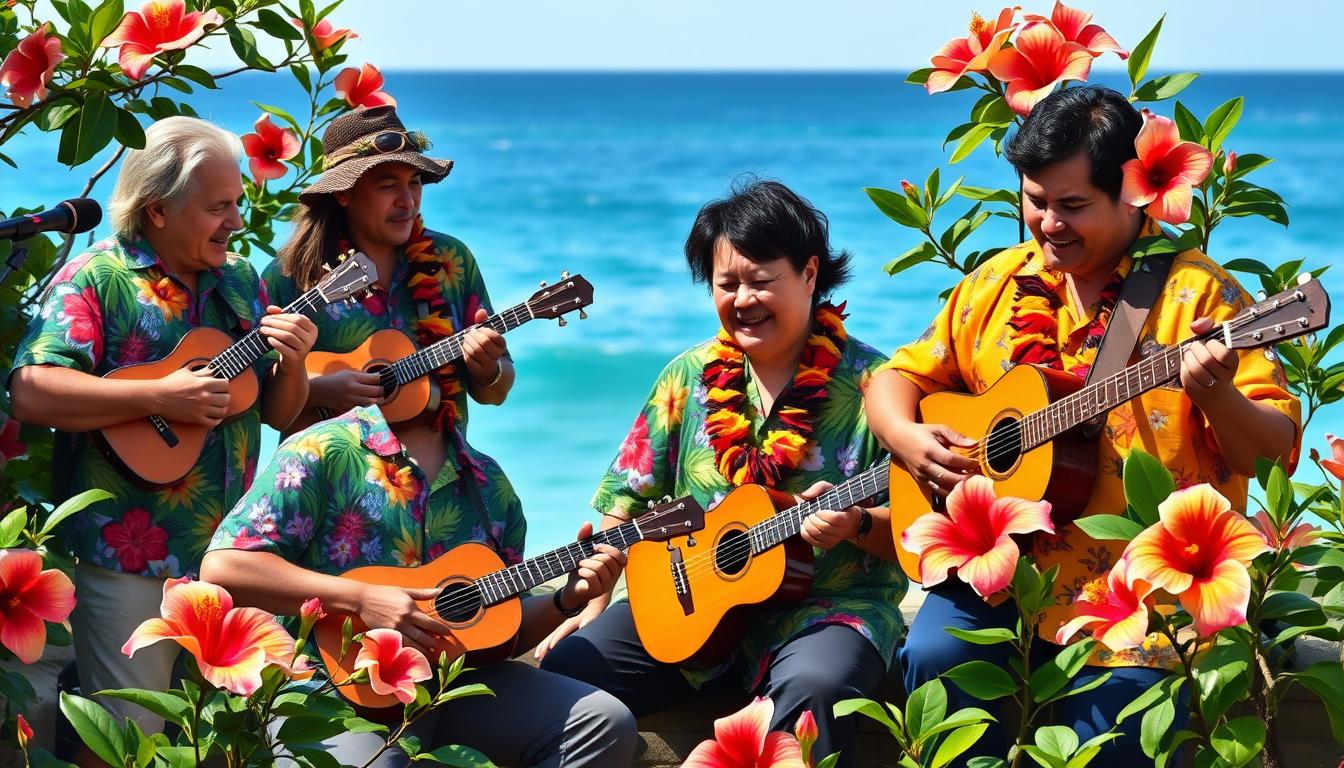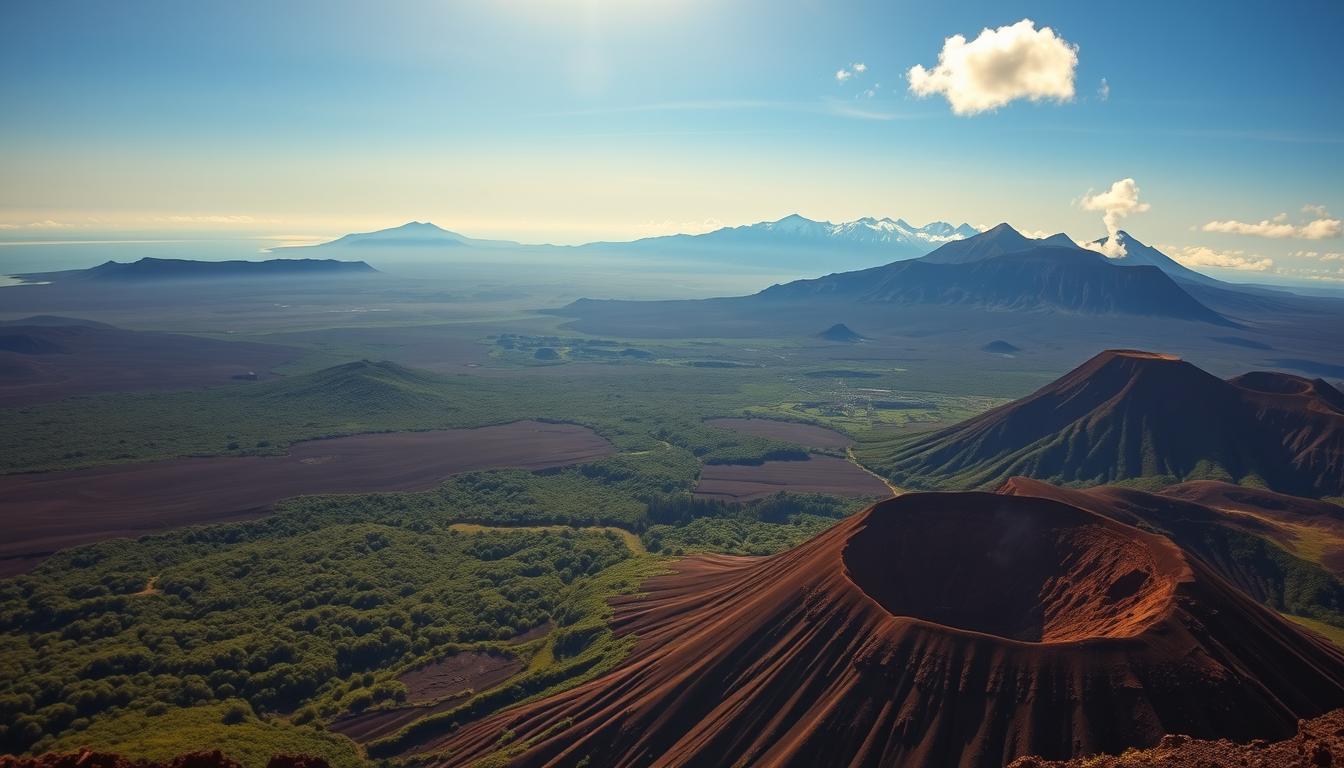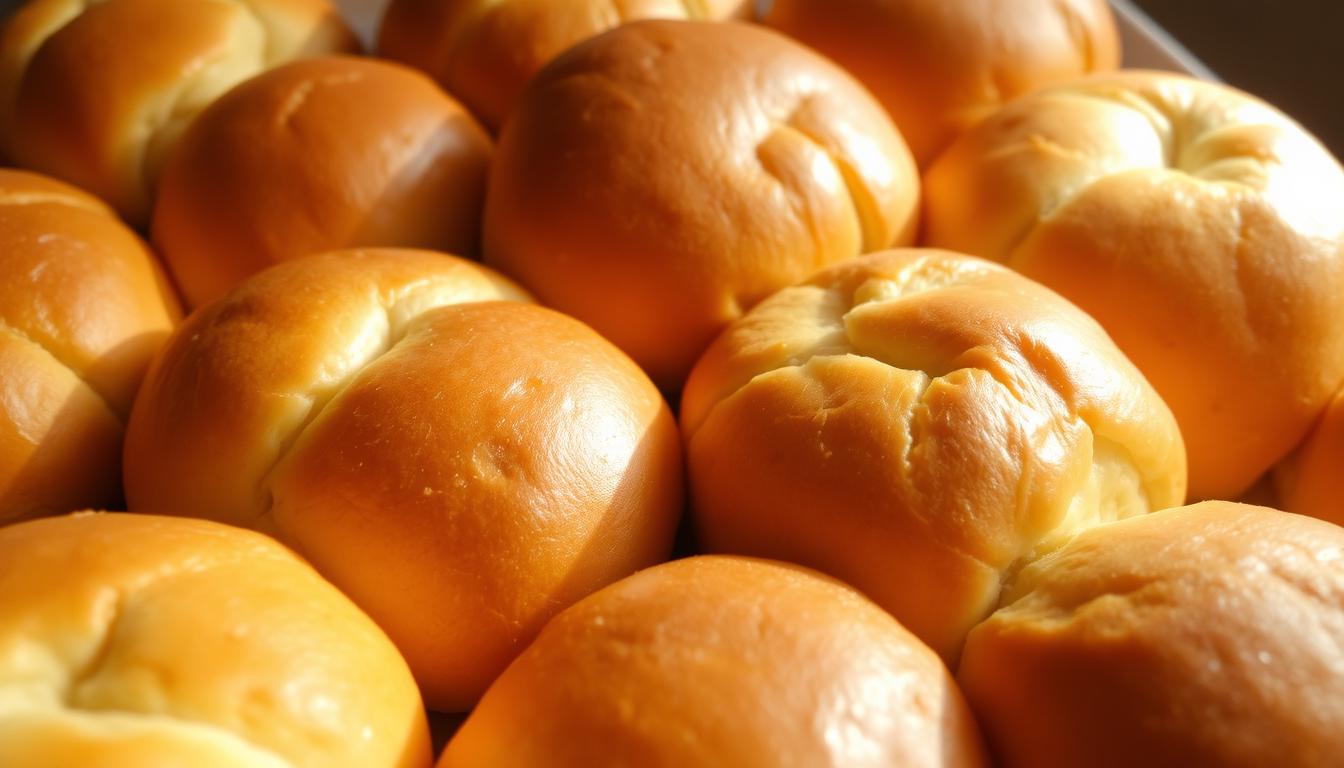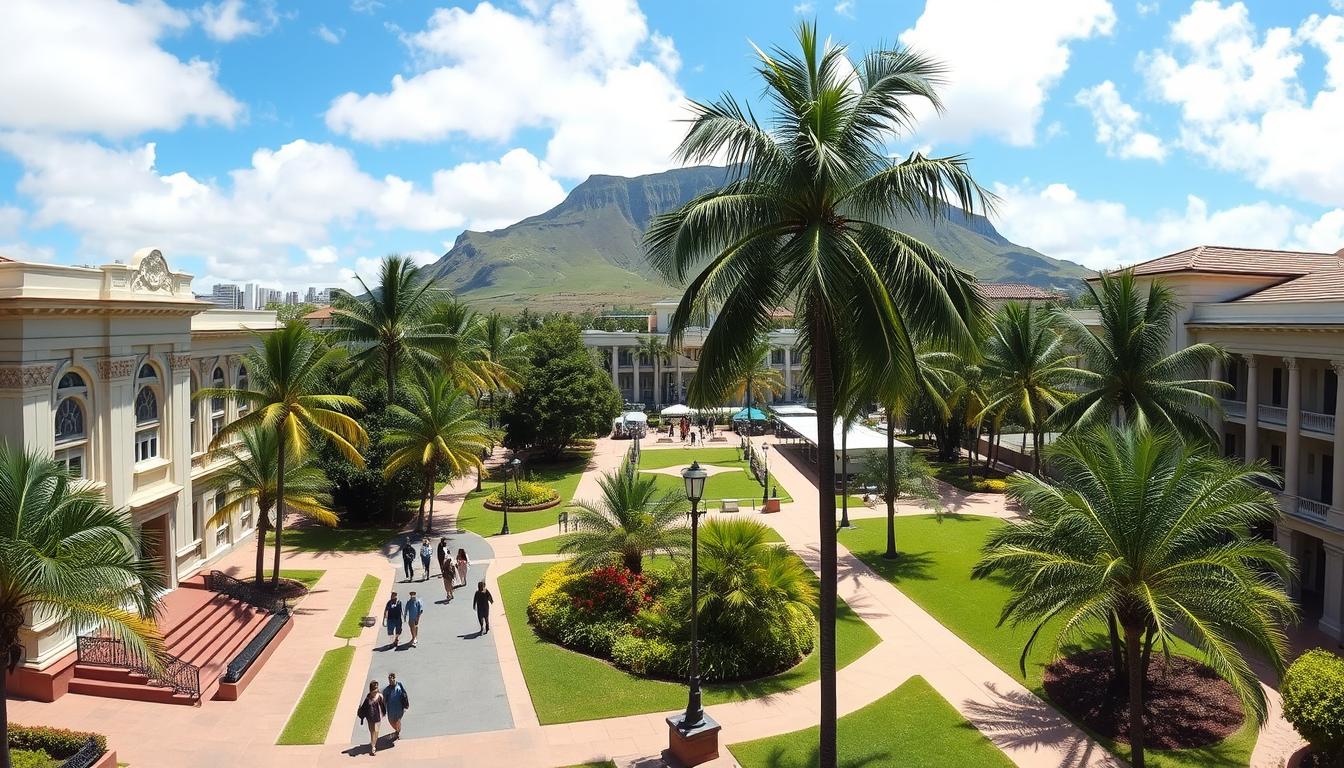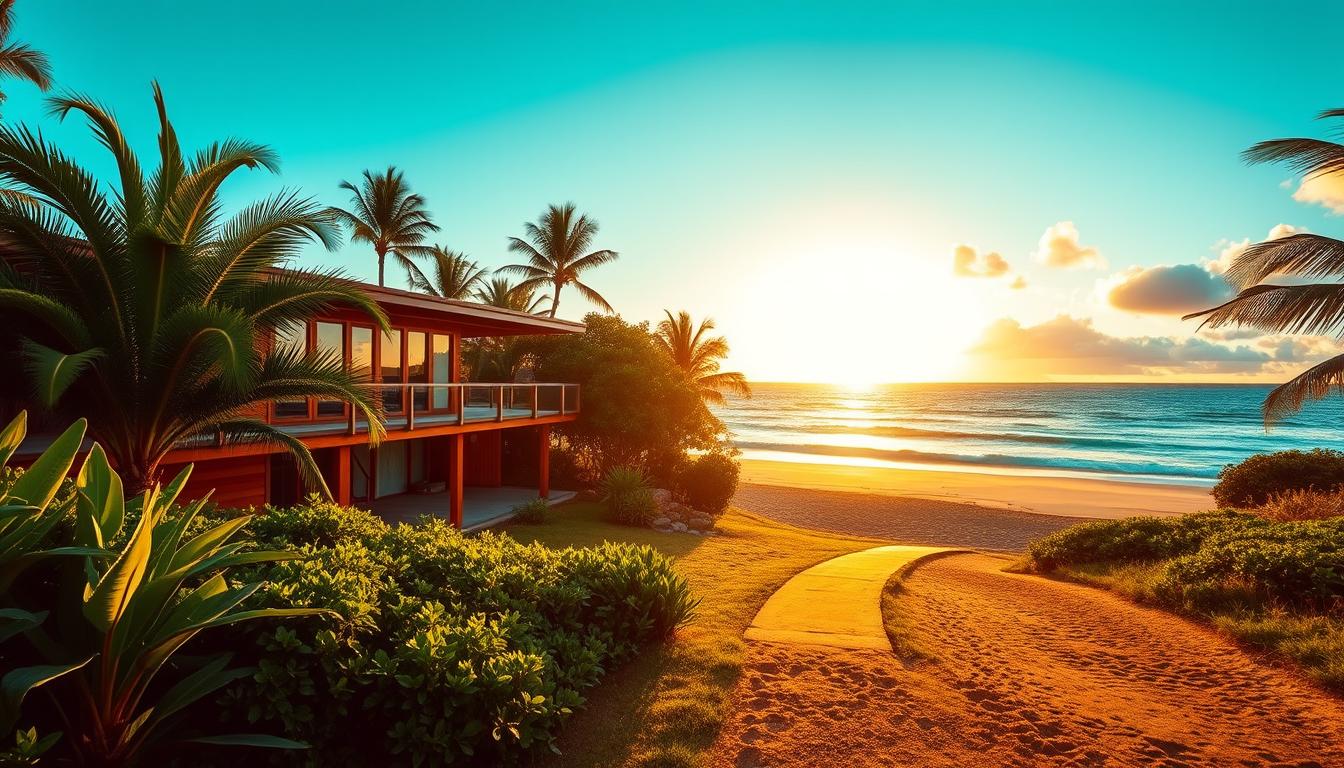My move to O’ahu from Phoenix, Arizona, in early 2022, opened my eyes to Hawai’i’s melodic essence. Music is deeply ingrained in island life, from the soft calls of local zebra doves to the heartfelt country tunes at Pearl’s Korean BBQ in Honolulu. Traditional Hawaiian music offers a window into the cultural heritage and love for the land, known as aloha ‘āina. This world of music, spanning over a thousand years, still shapes the music of the Hawaiian Islands today.
Key Takeaways
- Discover the rich history and styles of traditional Hawaiian music, which span over a millennium and continue to influence contemporary island music.
- Explore the melodic nature of Hawai’i, where music is interwoven into every aspect of island life, from the sounds of local wildlife to the soulful tunes at iconic restaurants.
- Understand the importance of aloha ‘āina (love of the land) and Hawaiian culture in shaping the vibrant and inspiring world of traditional Hawaiian music.
- Appreciate the enduring legacy of traditional Hawaiian music and its ability to captivate both residents and visitors to the Hawaiian Islands.
- Recognize the diverse influences and genres that have contributed to the evolution of traditional Hawaiian music over time.
Exploring the Enchanting World of Hawaiian Melodies
The musical landscape of Hawai’i is a rich tapestry, featuring the soft coos of local zebra doves and the rustling of Banyan leaves. It also includes a wide range of melodies. From the soulful country tunes at Pearl’s Korean BBQ to Fia’s hit “Love Me” in 2018, music is a core part of island life.
From the Gentle Coos of Zebra Doves to Melodic Island Tunes
When I moved to O’ahu, I was captivated by the melodies that filled the air. The blend of Hawaiian music, Hawaiian melodies, and island sounds creates a unique Hawaiian ambiance. This ambiance is a hallmark of island life and Hawaiian culture.
The 1960s brought prosperity and the baby boomer generation, sparking a musical revolution. Exotica music grew due to technological advancements and increased spending. “Hawaii Calls,” an album of traditional Hawaiian tunes, enchanted audiences in the 1960s with its harmonies and the allure of paradise.
Budget labels like Crown Records, Tops Records, and Pickwick International often featured exotica and other genres. In contrast, Capitol Records, known for its high engineering standards, produced legendary acts like The Beatles and The Beach Boys. Capitol Records ensured that albums like “Hawaii Calls” were compatible with both monophonic and stereophonic systems, making them timeless.
The microgroove technology in records like “Hawaii Calls” improved sound quality, playtime, and dynamic range. It also reduced background noise, captivating audiences with the Hawaiian nature and island sounds of the era.
The Rich Tapestry of Traditional Hawaiian Music
Traditional Hawaiian music, or kahiko, is deeply rooted in storytelling. Its mele (meaning ‘chant’ or ‘song’) commemorate key events and chronicle Hawaiian history, mythology, genealogy, and spirituality. Kahiko has evolved into entertainment and spiritual expression, often paired with hula dance. This sound and ethos shape contemporary Hawaiian music, preserving the cultural heritage of Hawai’i.
Mele: Vessel for Storytelling and Cultural Preservation
The Hawaiian chants, or mele, are more than melodies. They embody the islands’ history, mythology, and spirituality. Passed down through generations, these poetic verses are a living archive of the Hawaiian people’s identity and traditions. They recount ancient ali’i tales and celebrate the archipelago’s natural wonders, inspiring both natives and visitors.
- Mele are the primary means of transmitting Hawaiian cultural knowledge and history.
- These chants often accompany hula dances, creating a powerful synthesis of movement, rhythm, and storytelling.
- The mele reflect the deep spiritual connection between the Hawaiian people and their land, fostering a profound sense of place and identity.
As the Hawaiian language experiences a renaissance, the mele are crucial in reviving traditional Hawaiian culture. Through performance and preservation, these timeless chants keep the rich heritage of the islands alive. They resonate with the hearts and minds of all who experience the enchanting sounds of Hawai’i.
The Evolution of ‘Auana: Modern Hawaiian Music
The Hawaiian music scene is a dynamic, ever-changing mosaic, influenced by a wide range of cultures. ‘Auana, or modern Hawaiian music, showcases this ongoing musical transformation. It blends sounds from China, Jamaica, Japan, Mexico, Portugal, Puerto Rico, Samoa, and Tahiti, creating a unique Hawaiian sound.
At the heart of ‘auana are the slack-key guitar and ukulele. Introduced over a century ago, these instruments have become symbols of Hawaiian music. Israel Kamakawiwo’ole’s 1988 rendition of “Somewhere Over The Rainbow/What A Wonderful World” further cemented Hawaiian music’s global appeal.
Hawaiian music’s evolution mirrors the islands’ cultural heritage and the blending of diverse traditions. From the 1930s-1960s to today’s genre fusions, ‘auana continues to evolve, embodying the Hawaiian spirit.
| Influence | Impact on Hawaiian Music |
|---|---|
| China | Introduced instruments like the ukulele and contributed to the development of the Hawaiian sound |
| Jamaica | Influenced the emergence of the “Jawaiian” genre, a fusion of Hawaiian and reggae music |
| Japan | Inspired the use of electronic and synthesized elements in modern Hawaiian music, creating a unique “synth-pop” style |
| Portugal | Brought the ukulele to Hawaii, which has since become an iconic instrument in Hawaiian music |
The evolution of ‘auana, or modern Hawaiian music, celebrates the islands’ rich cultural heritage and the Hawaiian people’s enduring spirit. As it evolves, incorporating diverse influences and new approaches, it remains a captivating and dynamic expression of Hawaiian music.
Iconic Instruments: Slack-key Guitar and Ukulele
The ukulele, brought by Portuguese immigrants over a century ago, has become a symbol of the Hawaiian Islands. Artists like Israel Kaʻanoʻi Kamakawiwoʻole, known as Braddah IZ or IZ, have made this sound known worldwide. His version of “Somewhere Over The Rainbow/What A Wonderful World,” recorded in 1988, achieved global success. It was featured in TV adverts and movies, including “50 First Dates.”
The guitar, introduced by Spanish and Mexican cowboys in the early 1800s, gave birth to slack-key playing. This style involves loosening strings to create an open chord. Slack-key guitar emerged as a response to the missionaries’ influence in the late 18th century. The arrival of Spanish and Mexican cowboys in the late 19th century brought stringed instruments and romantic ballads into Hawaiian music.
Israel Kamakawiwo’ole’s Global Impact with “Somewhere Over The Rainbow”
Israel Kamakawiwo’ole, or “IZ,” was a Hawaiian musician whose rendition of “Somewhere Over The Rainbow/What A Wonderful World” became a global hit. Recorded in 1988, the song achieved chart success worldwide over the decades. It was featured in popular TV shows and movies, such as “50 First Dates.” IZ’s powerful yet gentle Hawaiian sound and emotive performance captivated audiences worldwide. This cemented the ukulele’s status as a beloved symbol of the Hawaiian Islands and their rich musical heritage.
| Instrument | Influence | Key Artists |
|---|---|---|
| Ukulele | Introduced by Portuguese immigrants, became emblematic of Hawaiian music | Israel Kamakawiwo’ole |
| Slack-key Guitar | Evolved from the introduction of guitars by Spanish and Mexican cowboys, characterized by open chord tuning | Gabby Pahinui, George Kahumoku Jr. |
Traditional Hawaiian Music Instruments
The rich tapestry of traditional Hawaiian music is woven together by a diverse array of captivating instruments. From the gentle coos of the ipu (single gourd drum) to the rhythmic resonance of the pahu (sharkskin drum), these instruments play a vital role in preserving and celebrating the island’s cultural heritage.
The ipu, a traditional Hawaiian percussion instrument, is divided into two distinct types: the ipu heke (double gourd drum) and the ipu heke ‘ole (single gourd drum). These instruments, crafted from natural materials, are often featured at lū’aus (traditional Hawaiian feasts) and kanikapila (informal musical gatherings), adding depth and character to the traditional Hawaiian music experience.
| Instrument | Description |
|---|---|
| Ipu | A single gourd drum used in traditional Hawaiian music. |
| Ipu Heke | A double gourd drum used in traditional Hawaiian music. |
| Pahu | A sharkskin drum that is a crucial instrument in the hula dance. |
| ‘Uli ‘Uli | A maraca-like instrument used in traditional Hawaiian music and dance. |
In addition to the ipu and pahu, the traditional Hawaiian music repertoire includes other captivating instruments like the ‘uli ‘uli (maraca-like implement), kā’eke’eke (bamboo percussion instrument), ohe hano ihu (nose flute), and ukeke (traditional Hawaiian string instrument).
These instruments, crafted from natural materials such as gourds, sharkskin, and bamboo, not only produce unique sounds but also serve as visual representations of the island’s rich cultural heritage. Their use in traditional Hawaiian music performances, from lū’aus to hula dances, continues to captivate audiences and preserve the essence of this enchanting musical tradition.
Celebrating Hawaiian Music Through Festivals
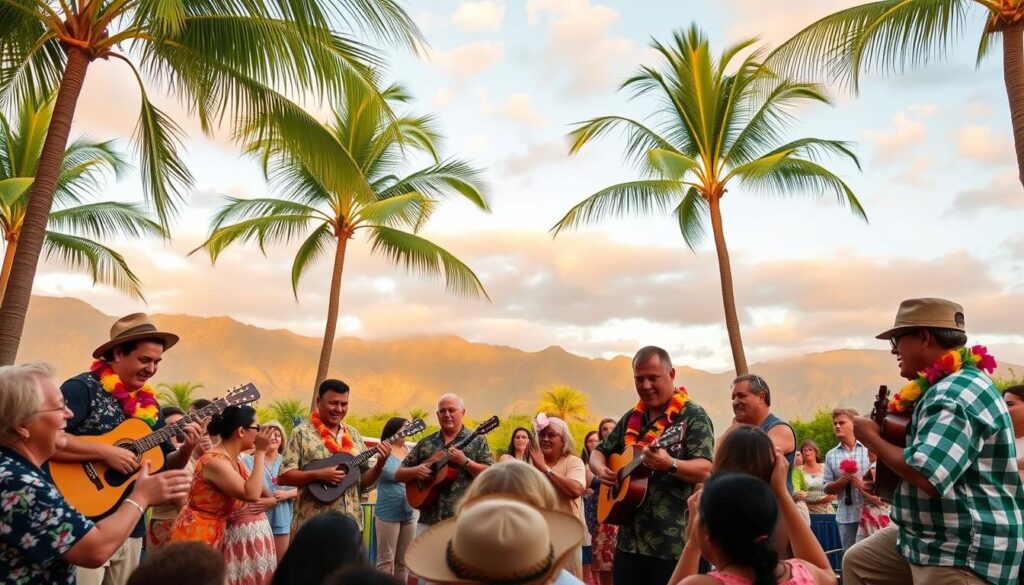
Hawaii’s rich musical heritage is celebrated year-round at various festivals. These events showcase the vibrant and diverse range of traditional Hawaiian music. They honor the cultural legacy and inspire audiences to engage with and preserve the island’s musical traditions.
Hawaiian Slack Key Guitar Festival and Merrie Monarch Hula Festival
The Hawaiian Slack Key Guitar Festival pops up in several locations across the Hawaiian Islands each year. It captivates audiences with the soulful and intricate sounds of this unique guitar style. Meanwhile, the prestigious springtime Merrie Monarch Hula Festival in Hilo is a week-long celebration of hula, the traditional Hawaiian dance form. It has been held annually since 1964.
These festivals celebrate the enduring spirit of Hawaiian music and dance. They preserve the cultural heritage while introducing it to new generations. They provide a stage for talented musicians, dancers, and cultural practitioners to share their art with the world. This fosters a deeper appreciation for the beauty and significance of Hawaiian traditions.
| Festival | Location | Significance |
|---|---|---|
| Hawaiian Slack Key Guitar Festival | Various locations across Hawaii | Showcases the unique and soulful slack key guitar style, a hallmark of Hawaiian music |
| Merrie Monarch Hula Festival | Hilo, Big Island | Week-long celebration of the traditional Hawaiian dance form of hula, established in 1964 |
These festivals serve as important platforms for the preservation and celebration of Hawaiian music and culture. They inspire audiences to engage with and appreciate the enduring traditions of the islands.
Live Music at Farmer’s Markets and Museums
The Hawaiian Islands are alive with the vibrant sounds of traditional and contemporary Hawaiian music. This enchanting music can be experienced in various public settings across the islands. From the lush farmer’s markets to the cultural hubs of museums, visitors and residents alike can immerse themselves in the rich tapestry of Hawaiian melodies.
Farmer’s markets scattered throughout the Hawaiian Islands are not just bustling hubs of fresh produce and local crafts. They also serve as vibrant stages for talented Hawaiian musicians. At the Pearlridge Center’s weekly Village Night Market in Aiea, for instance, captivating local artists like singer Rachel Faith delight audiences with their unique interpretations of beloved hits. They infuse the island’s musical heritage into contemporary favorites by artists such as Ben E. King, Sublime, TLC, and Amy Winehouse.
Museums, too, have become integral spaces for celebrating the diversity of Hawaiian music. The Hawaiʻi State Art Museum and the Honolulu Museum of Art frequently host performances by gifted local musicians and artists. These performances provide visitors with opportunities to experience the depth and range of Hawaiian music in visually stunning public settings.
Whether you’re browsing the stalls of a farmer’s market or exploring the galleries of a museum, the Hawaiian Islands offer ample opportunities to immerse yourself in the captivating world of live Hawaiian music performances. From the gentle coos of the iconic zebra dove to the rhythmic strumming of the ukulele, these musical experiences allow you to connect with the rich cultural heritage that defines the spirit of Aloha.
| Farmer’s Market | Location | Operating Hours | Number of Vendors |
|---|---|---|---|
| Waimea Mid-Week Farmers Market | South Kohala | Wednesdays, 9 am – 2 pm | Varies between 5 to 200 |
| Waikoloa King’s Shop Farmers Market | Waikoloa | Wednesdays, 8:30 am – 2 pm | Varies between 5 to 200 |
| Hilo Farmers Market | South Hilo | Wednesdays and Saturdays | Over 200 vendors |
| Farmers Market at The Mill | Puna | Saturdays, 9 am – 2 pm | Varies between 5 to 200 |
Intimate Venues for Diverse Hawaiian Music Styles
Beyond Honolulu’s iconic stages, a vibrant local music scene thrives in Chinatown’s intimate spaces. Places like BāS Bookshop are havens for diverse Hawaiian musical styles. From Jawaiian (Hawaiian reggae) to synth-pop, these venues captivate audiences.
These smaller, community-focused spaces offer a platform for both emerging and established artists. They highlight the dynamic and evolving nature of Hawaiian music. Visitors can immerse themselves in a variety of captivating performances, each offering a unique glimpse into the local music scene.
From Jawaiian to Synth-pop in Honolulu’s Chinatown
The intimate setting of BāS Bookshop in Honolulu’s Chinatown amplifies the emotional resonance of music. Artists blend traditional Hawaiian influences with contemporary sounds, captivating audiences with their unique interpretations.
Whether it’s Jawaiian’s infectious beats or synth-pop’s ethereal melodies, these venues celebrate diverse Hawaiian music styles. The intimate nature of these spaces fosters a connection between artists and audience. This allows for a truly immersive and memorable musical experience.
As the sun sets over Honolulu’s Chinatown, the local music scene comes alive. It pulses with rhythms and harmonies that captivate both residents and visitors. These intimate venues showcase the enduring spirit of Hawaiian music, highlighting its vast array of styles. They connect the past to the present and pave the way for future musical innovation.
Traditional Hawaiian Music
The rich tapestry of traditional Hawaiian music, or kahiko, is deeply rooted in ancient storytelling. Its mele (songs or chants) commemorate pivotal events, chronicling Hawaiian history, mythology, genealogy, and spirituality.
Kahiko has evolved into entertainment and spiritual expression, often performed with hula dance. This foundational sound and ethos continue to influence contemporary music from the Hawaiian Islands. It preserves the vibrant cultural heritage of Hawai’i.
Instruments of Traditional Hawaiian Music
The original instruments of the Hawaiian Islands included the ipu (single gourd) and the ipu heke (double gourd), large hand drums from hollowed-out gourds. These gourd instruments established rhythm through percussive movements in Hawaiian music and storytelling.
- Non-gourd instruments like the ‘ili ‘ili, smooth, water-worn stones similar to castanets of Latin music, were also used for rhythmic elements.
- The pahu, a hand drum covered with sharkskin, introduced from Tahiti, contributed to the evolution of Hawaiian music.
- The Portuguese introduced stringed instruments to Hawaii, including the braguinha which later became the ukulele, and steel guitars. Families adapted the steel guitars to create the unique Hawaiian slack-key guitar sound.
Hawaiian music history dates back to ancient times, with the first chants, known as mele, likely created by early Polynesian settlers around 500 AD. The introduction of Western influences in the 19th century led to the blending of Hawaiian and Western musical styles, creating genres like hapa haole music.
Today, Hawaiian music and dance continue to play a significant role in the culture. Popular styles include hula music, slack key guitar, traditional Hawaiian music, and hapa haole music. The preservation of this rich musical heritage ensures that the spirit of aloha and the essence of the Hawaiian Islands are woven into the melodies that captivate audiences worldwide.
The Spirit of Aloha in Hawaiian Melodies
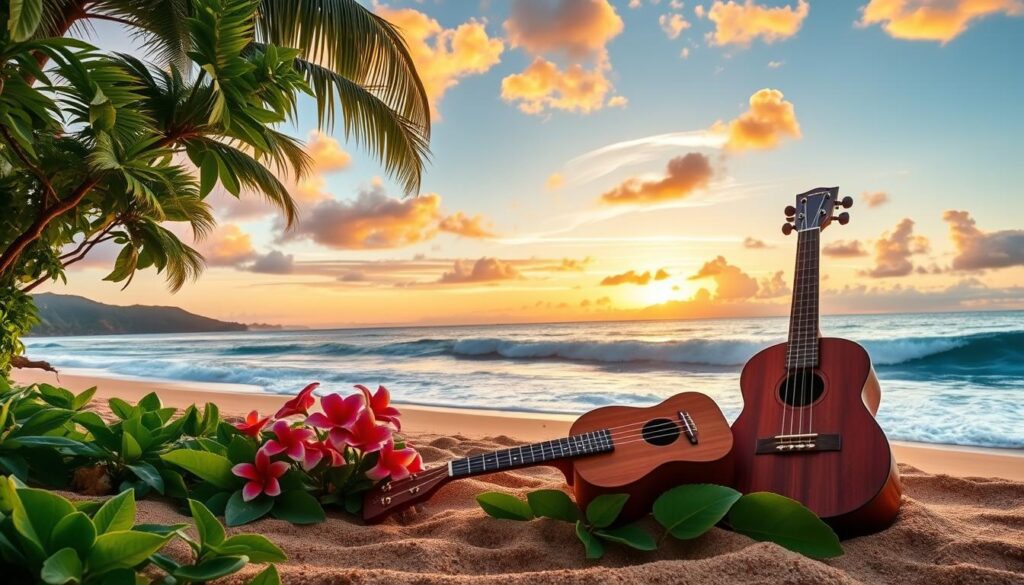
The spirit of aloha in Hawaiian music reflects the islands’ rich cultural heritage and vibrant essence. From the ukulele’s gentle sway to hula’s powerful chants, Hawaiian melodies capture the heart of this Pacific paradise. Don Ho once called Hawaii “the most precious jewel in the world,” and its melodies echo with wonder and reverence.
Israel Kamakawiwo’ole, a legendary Hawaiian singer, left a lasting impact with his untimely passing at 38 in 1997. His album “Facing Future,” released 25 years ago, remains a top seller, inspiring new generations of musicians. IZ’s soulful renditions of classics like “Somewhere Over the Rainbow” made him a cultural icon, changing Hawaiian music forever.
The aloha spirit in Hawaiian melodies is deeply ingrained in the islands’ society. In 1986, Hawaii’s Revised Statutes enshrined aloha, defining it as kindness, unity, agreeableness, humility, and patience. This community spirit is seen in hula performances at the Merrie Monarch Festival and in intimate gatherings at farmer’s markets and museums.
For visitors, the aloha spirit is omnipresent, felt in tour guides’ helpfulness, locals’ smiles, and immersive experiences. Whether it’s slack-key guitar melodies or traditional mele chants, Hawaiian music connects listeners to the islands’ heart and soul. It invites all to experience the warmth and wonder of the aloha spirit.
Discovering the Essence of the Islands Through Music
Exploring the rich traditions and diverse styles of Hawaiian music allows visitors and locals to connect deeply with the islands and their people. Attending live performances at local venues or participating in music workshops are great ways to dive into the Hawaiian music scene. These experiences offer a chance to understand the cultural significance and spiritual essence behind these melodies.
The music of Hawaii has a unique ability to transport listeners and foster a deep appreciation for the islands’ cultural heritage. Hula chants, mesmerizing slack-key guitar, and iconic ukulele performances showcase the Hawaiian music tradition. These experiences provide a glimpse into the heart and soul of the archipelago, inviting visitors to connect with the Hawaiian spirit through sound.
Exploring Cultural Significance and Immersive Experiences
The rhythmic beats of traditional percussion and the soulful harmonies of island music hold deep cultural significance. Immersing oneself in these musical experiences offers a profound understanding of the islands’ history, customs, and the cultural significance embedded in the Hawaiian heritage.

Scott Sweeney is the creator of Virtual Hawaii 360. Scott is a professional marketer and a lifelong Hawaii enthusiast. Scott splits time between Oahu and Dayton, Ohio. In addition to his marketing endevours, he is also a published Ukulele musician.

